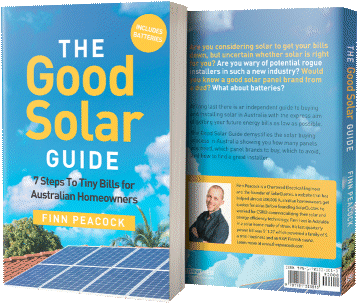
Victorians have collectively saved a huge bundle of bucks on the up-front costs of solar power, battery and hot water systems through state rebates and loans. Find out how much here.
How Much Has Been Saved On Systems Under Solar Homes?
Launched in August 2018, Victoria’s Solar Homes program has to date provided $750 million in rebates according to the Allan Government. Added to that is more than $365 million in interest-free loans issued, for a program total of around $1.115 billion.
Then there’s the substantial power bill savings recipients have enjoyed and will continue to benefit from with their subsidised systems.
“Our focus is on delivering cheaper power bills for Victorian families – helping to cut the cost of living and put more money back in their pockets,” said Victorian Minister for Energy and Resources Lily D’Ambrosio.
Beyond rebate/loan recipients, the program has provided wider benefits; among which are thousands of jobs, helping to lower the state’s electricity-related carbon emissions and putting downward pressure on wholesale electricity prices during the day.
Around 30 per cent of Victorian homes now have solar panels installed according to the state government; more than double the proportion when the Solar Homes program began.
Just in terms of solar panels supported under the program, more than 2.3 gigawatts of capacity has been installed, spread among 326,000 solar power systems as at the end of September 2025. A record 76,530 PV systems were installed last financial year, along with 9,256 heat pump hot water systems.
The program has also provided $5.7 million in rebates for more than 110 apartment buildings to install solar panels, with around half of these occupied by renters.
Current Solar Homes Incentives
Solar panel rebate: (actually an up-front discount) of up to $1,400 for the installation of solar systems for Victorians with existing homes or homes under construction. There’s also an optional interest-free loan available of up to $1,400 to be repaid over 4 years. Both are also available for rental property landlords.
For apartment buildings or town house complexes, there’s a rebate of up to $2,800 per household or up to $140,000 per property.
The Victorian incentive can be claimed along with the national solar rebate. Learn more about Victoria’s solar panel rebate.
Hot water rebates: (also an up-front discount) of up to $1,000 (or up to $1,400 for locally made products) for eligible heat pump and solar hot water products. Additionally, more can be saved through Victorian Energy Upgrades (VEU) hot water discounts. Further information here.
There has previously been state government support for solar batteries under the program too, with a rebate of $3,500 originally provided that was reduced to $2,950 in 2022. Battery rebates were dropped entirely in mid-2023 in favour of interest-free loans of up to $8,800 repaid over 4 years, but the loan scheme ended in May this year. However, the federal government’s battery rebate came into play soon after.
21,298 home batteries were installed with support from Victoria’s program.
Solar Homes Hotspots
The top 10 local government areas (LGAs) for PV systems installed with a Solar Homes rebate and/or loan as at the beginning of October 2025 were:
- Casey: 30,258
- Wyndham: 27,396
- Hume: 18,105
- Melton: 16,281
- Whittlesea: 15,771
- Greater Geelong: 13,210
- Knox: 8,499
- Mornington Peninsula: 8,239
- Brimbank: 8,158
- Cardinia, 8,082
There are 79 LGAs in Victoria and the 10 above account for approximately 47% of solar panel systems installed under the program to date.
The City of Casey, Victoria’s most populous municipality, includes suburbs and localities such as Berwick, Clyde, Cranbourne, Doveton, Endeavour Hills, Hallam, and Hampton Park. The population estimate for the LGA in mid-2024 was 405,415.
Will Solar Homes Funding Last The Distance?
The Solar Homes Program aims to subsidise systems for up to 777,000 households, with an overall decade-long investment of around $1.3 billion including the value of loans. So, there’s around $185 million in the kitty so to speak to take it through to 2028; assuming that’s still the plan and budget.
Whether you’re in Victoria or elsewhere in Australia, you can see what support is available in your neck of the woods on our solar rebates and subsidies page; which includes summary information on EV incentives as well.
Incentives can change or disappear altogether quickly, sometimes with little (or no) warning. To stay up-to-date with what’s happening, subscribe to the SolarQuotes weekly newsletter.

 RSS - Posts
RSS - Posts



The amount of free energy that a domestic roof can yield, even down here in Victoria, continues to surprise me, as the roof over my head ticks over 10.2 MWh over the last 20 months. On sunny and even cloudy days, that’s usually limited by consumption, with production curtailed by lack of export opportunity – something that would have been very nice to have.
That only 30% of households have solar seems a missed opportunity, not only for them, but for the state and the world. But with 3 hrs of midday free electricity publicised on ABC radio today, we are reminded that batteries are the critical network priority now. More solar generation can only be fully utilised when there are more batteries, bringing down prices in the expensive evening peak. With the battery rebate predicated on presence of solar generation, domestic batteries will help reduce peak consumption more than they help absorb peak generation, as the mandated solar then fills them instead. Good: Just more, regardless?
Would have been even better if they’d had the subsidy for resistive hot water and diverter as well as heat pumps seeing how most people are putting in bigger solar and get bugger all fit !!
Peter, that would also help absorb the midday over-generation peak. Those damn heatpumps have the HWS hot with too little electricity consumption to be fully fit for purpose at noon in the new energy (over)abundance paradigm. Not all of us have a dishwasher to run around midday, the aircon draws only piffle, and once the BEV’s up to snuff, where can it all go? (I forgot to turn off the RCAC heating last night – it was still running this morning. That pulled the battery down to 87%. Due to deep overcast, with some rain, & simultaneous EV charging, it wasn’t back up to 100% before 10 a.m.)
Mind you, if those young-uns complaining about the climate doings of oldies also all had BEVs charging during the peak, they might have helped absorb the peak – while displacing their fossil fuel which is currently being thrown on the fire. It’s what we do from here on out which is generating the higher climatic overshoot.
HEVs aren’t EVs, they’re climate-destroying HICEs. PHEV minimum, please.
Yeah I’d rather a ev can’t see much sense in phev having to cart a extra engine around with over 2000 moving parts to wear out just for a bit of extra range !!
Bad idea for Victoria – Resistive chews through 3-4x the amount of Electricity as Heat Pumps and in winter adding 6-10kWh of load to to the grid per household will just mean we need to burn more expensive gas.
Might make sense in Queensland, but doesn’t make sense here.
No the government are bringing in free electricity for a minimum of 3 hours per household so with a 3.6 kw system that’s 10.8 kw you could heat your hot water everyday and not many people would need more than that and you’d have all the previously mentioned benefits of resistive !!
The Free Electricity wasn’t announced for Vic – just NSW, Queensland and SA.
And where would the grid get extra electricity from in the middle of winter? At the moment it would likely be coal + gas, as solar contributed 9.3% of generation this winter and 23.4% of generation in summer. Solar Curtailment was more than 8x higher in summer than winter and this gap will only keep growing.
I am all for Renewables. But looking at the Price development the Rebates seem to profit mainly the Manufacturer and retailers. As I was planning to switch from Gas to A Hot water heat Pump I checked the price of the Sanden Eco Plus – 315EQTAQ which now was, just looked up one retailer $6,699,- not long ago $5,800. Not surprising really as we live in a Supply and demand society. But there ought to better, fairer ways of promoting the switch to Renewables.
You should consider a resistive hot water a new dux 315 litre hot water system is only 1310 $ delivered and you could run it for FREE with the new 3 hour idea ,they last twice as long as a heat pump as no moving parts, cost less to install and maintain, don’t make any noise, hotter water, I already get free hot water with mine using a diverter !!